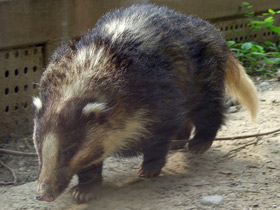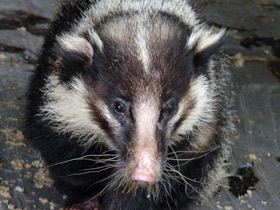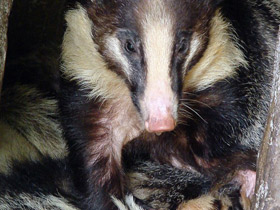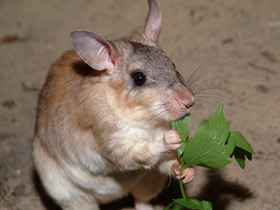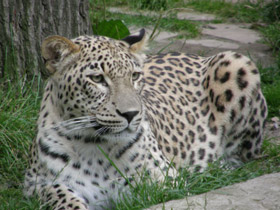The greater hog badger (Arctonyx collaris)
The greater hog badger (Arctonyx collaris) is a very large terrestrial mustelid native to Southeast Asia. It is listed as Vulnerable in the IUCN Red List of Threatened Species because the global population is thought to be declining due to high levels of poaching.
Taxonomy
It was formerly thought to be the only species in the genus Arctonyx, displaying heavy variation throughout its wide range, leading it to be classified as having many subspecies. However, a 2008 study found that Arctonyx should be split into three species. The following subspecies were formerly recognized, but are now thought to be conspecific with little distinction between one another:
- Greater hog badger A. c. collaris (Cuvier, 1825) – lives in the Eastern Himalayas;
- Indochinese hog badger A. c. dictator (Thomas, 1910) – lives in southern Thailand and Indochina;
- Burmese hog badger A. c. consul (Pocock, 1940) – occurs from Assam to Myanmar.
Appearance
Arctonyx collaris is a species of carnivorous mammal in the family Mustelidae. It is the only species of its genus.
Arctonyx collaris is the largest representative of the badger subfamily: body length reaches 55-70 cm, not counting the 15 cm fluffy tail; weight varies from 7-14 kg.
The "pig" part of its name is given to this beast because of its habit of digging the ground, not only with large, strong claws, but also with a very pig-like snout with a long face. Six subspecies of this species are known, including A. c. albugularis from southern China and A. c. leucolaemus from northern China.
The legs of Arctonyx collaris are short and thick, and the front legs have large, light claws designed for digging. Its body is stocky, dense and elongated; the head is elongated and conical, with small, wide-set eyes. The colouring of Arctonyx collaris is almost the same as that of its Eurasian counterpart, with some notable differences. The coat of Arctonyx collaris is medium grey or yellowish brown, with black and white markings on the face. The face itself is mostly white with two black stripes running from the nose through the eyes and ears to the neck. Legs, feet and lower body black. The throat is white, in contrast to the Eurasian badger, whose throat is black. The tail of Arctonyx collaris is longer, the forelegs have white claws (Eurasian badger has black claws).
Habitat
The species is distributed in Southeast Asia: Bangladesh, India, Bhutan, Burma, Thailand, Laos, Vietnam, Cambodia, Malaysia, Indonesia and the island of Sumatra. Sumatra. Arctonyx collaris is characterised by a wide variety of habitats: wooded plains, forests and high altitude hills (Arctonyx collaris ascends up to 3500 m above sea level), wooded areas, tropical forests (jungle), agricultural fields.
Nutrition
The diet of Arctonyx collaris includes: small mammals, insects, roots, tubers and fruits. Their favourite food is earthworms, which they dig out of the soil with the teeth and incisors of their lower jaw. These animals find their food thanks to a highly developed sense of smell, sniffing out worms from the subsoil.
Lifestyle and peculiarities
Arctonyx collaris is nocturnal (but in India it can also be seen in the early morning or late afternoon), during the day it hides in a burrow it has dug or hides in natural shelters (hollows under rocks or boulders, in riverbeds). When attacked by a predator, the Arctonyx collaris defends itself with its claws and strong teeth. The tedus has a thick skin, which protects it well from the teeth of its enemies. The colour also serves as a warning that it is dangerous and best left alone.
Like other rabbits, it has anal glands that secrete a caustic secretion.
Arctonyx collaris is known to hibernate from November to February (March).
Social behaviour and reproduction
Arctonyx collaris have a rather nasty temperament. Before the mating season, they become very aggressive and often attack their conspecifics. The clashes are accompanied by a display of sharp teeth and a dreadful stench emanating from two glands near the anus. This reception is assured for anyone who invades their territory, marked with urine or the same stinking liquid. Only top predators, such as tigers, red wolves and leopards, are capable of dealing with these determined creatures.
Little is known about the social structure of Arctonyx collaris and their reproduction. It is likely that these animals lead an isolated lifestyle, as they are most often found alone (except for females with cubs, which move around the den area). Pregnancy in badgers lasts about 10 months. On this basis, it is assumed that Arctonyx collaris has a delayed embryonic development. In February and March, the female gives birth to 2-4 cubs. The newborns weigh about 60g. Lactation lasts up to 4 months. The pups reach adult size at 7-8 months. Arctonyx collaris can live up to 14 years in captivity.
Subspecies
- Arctonyx collaris albogularis;
- Arctonyx collaris collaris;
- Arctonyx collaris consul;
- Arctonyx collaris dictator;
- Arctonyx collaris hoevenii;
- Arctonyx collaris leucolaemus.









